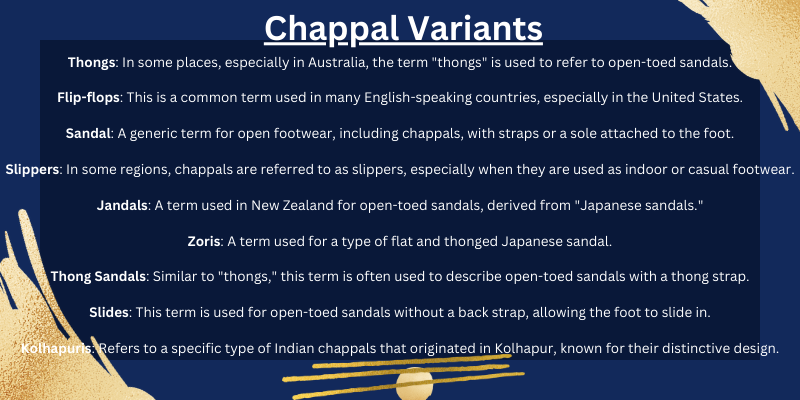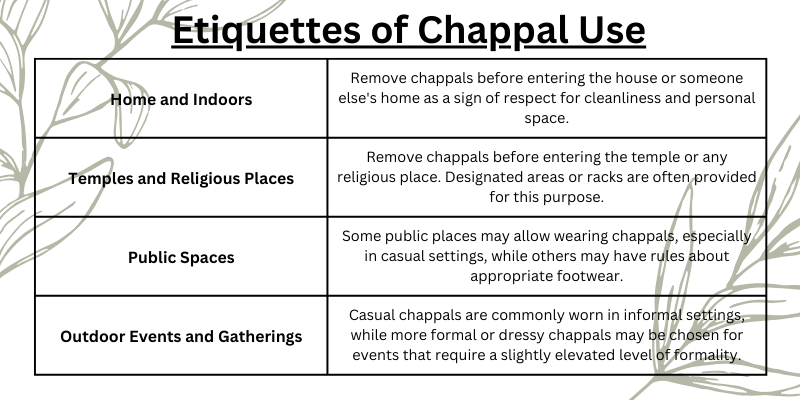![]()
Have you ever thought about what is chappal in India? Yes, those things you slip your feet into each time you head out. However, they are more than just a normal piece of footwear for us Indians, whose entire lives revolve around them. (Pun unintended!)
Life is a crazy hustle in a country of 1.5 billion people, and chappals are your sidekicks – always there, quietly accompanying you wherever life takes you. Just like Robin is there for Batman. Navigating the daily chaos isn’t possible without these sidekicks.
What is Chappal In India? Serious Insights
Okay, it’s time for the real talk. Let’s dig into the details to understand what chappal means to us Indians.
-
Comfort in Simplicity:
Chappals are the most underrated members of the footwear world. No complicated straps, no fancy laces – just a simple, unassuming design. Just slide your feet in, and you’re good to go – from the bathroom to the crowded marketplace, whenever, wherever. It’s like they’ve got your back (or your feet, in this case).
-
Weather Warriors:
India’s got everything from scorching heat to chilly days, right? Again, chappals have you covered. When it’s hotter than a curry pot, their open design lets your feet breathe. And, when the cold creeps in, there’s a snug version to keep you warm and comfortable.
-
Tradition on Your Feet:
Have you ever worn traditional attire? Well, donning a pair of chappals feels the same. Whether you’re strolling through city streets or village pathways, your chappals silently scream, “tradition.” Think of it like wearing your identity. Period.
-
Cultural Vibes:
In India, culture and chappals go hand in hand. Temples, mosques, homes – wherever traditions call for bare feet, chappals are the easy slip-ons that fit right in. Mind you, some cultures treat chappals as the most respectable version of footwear.
-
Casual Fashion:
Here’s the thing – chappals aren’t just about comfort but style statements too. They seamlessly slide from formal occasions to casual hangouts, making you wonder if your low-key footwear is more versatile than your wardrobe.
-
Household Heroes:
Home is where the chappal is. Imagine wearing shoes every time you need to visit the toilet when at home, and then you’ll realize what I mean. Chappals are indispensable.
- Suggested Reading: Stride in Style: Chappal Brands in India
What is Chappal in India? Definition:
Let’s face it. There is no hard and fast chappal definition even in a country that is the birthplace of chappals. However, we can loosely define it as “traditional open-toed sandals, often made of leather or rubber, with a simple design consisting of a sole held to the foot with a V-shaped strap.” Often, the term chappal is used interchangeably for thongs, flip-flops, sandals, slippers, slides, Jandals, Zoris, and Kolhapuris.
While these terms have a lot of overlap, they represent different styles and designs. The name also varies from region to region. Take, for instance, chappals and slippers. What we Indians know as chappal might pass off as slippers outside the Indian Subcontinent. Likewise, Kohlapuris originate from Kohlapur, and Jandals are found in New Zealand.
- Suggested Reading: Casual Comfort: Difference between Chappal & Slippers

What is Chappal In India? History
Like all things, chappals originated out of sheer necessity. Ancient Greeks, Egyptians, and Indians felt the need for some protection for their feet when navigating inhospitable terrains, hence, the chappal. Again, like all things, chappals also evolved with time.
-
Padukas:
The earliest form of chappal, or footwear for that matter, was Pudukas. Typically made of wood, its origin dates back to the Vedic age. The Hindu scriptures are overflowing with the mention of Padukas, which speaks for their popularity and importance. Even a person’s social standing was determined by the type of Padukas he wore. They featured a basic design with just a simple wooden platform and no straps or embellishments.
-
Classical Chappals:
Chappals as we know them today evolved in the medieval period. Unlike Padukas, they were made of leather and had a strap to keep the foot firmly on the footbed. Note that, chappals evolved differently in different regions across India, according to the region’s climate, culture, economy, and other factors. So, don’t be surprised if a traditional Himachali Chappal differs from the traditional South Indian chappals.
-
Cultural Influence:
The earliest innovation in footwear came from the Romans in the form of the closed-toe design. As trade routes expanded, the world woke up to this innovation. Europeans came up with footwear with elaborate designs and new materials and introduced them to lands they conquered. As European influence melded with local traditions, chappals saw a fusion of styles.
-
Mass Production:
Come the 20th century, chappals became largely mass-produced. Rubber soles, synthetic materials, and standardized sizing just made chappals more affordable and accessible. Lately, we are seeing trends favoring eco-friendly materials.
What is Chappal in India? Etymology
Unlike the object it is used to define, the term “chappal” has a relatively recent origin. The world was introduced to the term in 1893, thanks to E. F. Knight. How the term came into existence is a story in itself. For some, it stems from a Telugu word “Ceppu,” which, in turn, owes its origin to the Proto-Dravidian word “Keruppu,” meaning “sandal”.
However, some link the term to the Persian word, “Chāpār,” meaning foot. Chāpār colloquially became Chappal with time. Regardless of the origin, the term, and the object it stands for, are a part of our culture, history, and language.
What is Chappal in India? Components
Let’s go beyond the soles and straps to explore Chappal’s anatomy.
1. Sole:
The sole is the foundation of comfort. It could be rubber for durability, leather for a classic touch, or even foam for that cloud-like feel. Simply put, different materials cater to different needs.
2. Straps:
Straps aren’t just about holding your feet in place; they’re a style statement. Leather, fabric, or even metallic – the straps add character and flair to your chappals, depending on the material.
3. Footbed:
Ever noticed that cozy feeling when you step into your chappals? Thank the footbed. Whether it’s padded, contoured, or lined with soft fabric, the footbed is all about giving your feet that extra bit of love.
4. Insole:
The insole isn’t just there for show but support. Arch support technology varies, ensuring that your feet receive comfort, especially during long walks or busy days.
- Suggested Reading: Insole: Uses, Types, & Best Insoles for Shoes
5. Toe-Tale:
The toe design can make or break the style. Whether it’s an open-toe design for breathability or a closed-toe style for a bit more coverage, this component sets the tone.
6. Heel:
Some chappals come with a hint of elevation in the heel area. From flat wonders to a slight lift, heel height adds a touch of sophistication to your overall look.
7. Closure:
Closures determine the chappal’s functionality and style. Buckles, zippers, or a simple slide-in design – each closure type brings its function and charm.
8. Stitching:
The way a chappal is stitched speaks volumes about its craftsmanship. Intricate stitching adds a touch of detail, making your chappals not just footwear but a work of art.
9. Embellishments:
It is easy to come across chappals adorned with embellishments for a touch of glamor and elegance. Beads, stones, and embroidery – everything goes.
10. Outsole Outlook:
The outsole, the part that touches the ground, helps you achieve grip. Whether it’s a textured rubber sole or a patterned design, the outsole ensures you stay steady on your feet.
Types of Chappals based on Materials
By now, you know a thing or two about what is chappal in India. Let’s move further with types of chappals based on materials.
-
Leather Chappals:
Let’s kick things off with the classics – leather chappals. They are as durable, timeless, and comfortable as chappals can get while also being traditional and sophisticated.
Pros: |
Cons: |
| Stylish and versatile | Costs More |
| Durable and wear-resistant | Requires maintenance |
| Breathable and comfortable | Susceptible to water |
| Molds to the foot’s shape over time | Might feel stiff initially |
| Natural Material | Not animal-friendly |
-
Rubber Chappals:
It is easy to fall for rubber chappals. Since they are lightweight, waterproof, and cheap, no prizes for guessing why. From the bathroom to the beach, they go wherever you go.
Pros: |
Cons: |
| Affordable and easily available | Less breathable |
| Water Resistant | May cause sweating in warm weather |
| Lightweight & Durable | Limited style options |
| Easy to clean and maintain | Lacks Style & Sophistication |
| Variety of Designs | Less Eco-friendly |
| Shock-absorbent & offers good support | Less comfortable over time |
-
Jute Chappals:
Since jute is a natural and biodegradable material, Jute Chappals are a step towards a cleaner planet. Besides being sustainable, they are breathable, stylish, and versatile.
Pros: |
Cons: |
| Eco-Friendly | Less Durable |
| Breathable | Color might fade |
| Comfortable | Limited Water Resistance |
| Versatile | Not suitable for monsoon & winter |
-
Fabric Chappals:
What do you get when comfort meets fashion and creativity? Well, of course, fabric chappals. Count on them for great style, breathability, easy upkeep, and washability.
Pros: |
Cons: |
| Stylish & Comfortable | Not as durable |
| Breathable & Lightweight | Retains odor |
| Washable & Easy to Care for | Susceptible to water & Stains |
| Available in various styles | Less Formal Appeal |
-
Synthetic Chappals:
On a budget but don’t want to compromise on style? Say hello to synthetic chappals – the cheapest chappals on the market. Faux leather, innovative materials, and a range of styles that won’t break the bank. Practicality just got a stylish makeover.
Pros: |
Cons: |
| Affordable | Not eco-friendly |
| Durable | Not as comfortable |
| Water Resistant | Retains heat & Odor |
| Stunning range of styles | Less Breathable |
| Easy to Maintain |
-
Cork Chappals:
Naturalists’ delight, Cork chappals weigh less, resist moisture, absorb shock, and look great. Smooth, earthy, and utterly comfortable, they up your footwear game.
Pros: |
Cons: |
| Eco-friendly | Expensive |
| Shock absorbent | Water Sensitive |
| Highly Comfortable | Limited Variety |
| Extremely Lightweight | Prone to staining |
| Provides insulation against heat & chill | Durability Concerns |
-
Foam Chappals:
Experience the cushioning that pampers your feet and gives you the illusion of floating on air. They are featherweight, easy to upkeep, pocket-friendly, and spoil you for style choices.
Pros: |
Cons: |
| Lightweight | Prone to wear & tear |
| Budget-friendly | Not water-resistant |
| Offers Great Cushioning | Lacks much support |
| Easy to maintain | Might flatten over time |
| Various Styles Available |
What is Chappal in North & South India?
Chappal preferences differ as we travel from North to South, thanks to the different social, cultural, and climatic conditions. You come across Juttis, Mojaris, and other chappal variants in Uttar Pradesh, Punjab, Haryana, and Delhi, whether for weddings, festivals, or daily wear. These embellished chappals speak of the region’s vibrant and celebratory lifestyle. Need I say, North Indians have a liking for Kolhapuri Chappals?
Venturing down south, the chappal scene transforms. States like Karnataka, Tamil Nadu, Kerala, and Andhra Pradesh offer a stunning variety of chappals, slippers, and sandals. The ever-popular Kolhapuris continue to hold their ground, but leather sandals with intricate designs and motifs are quite popular as well. Comfort, especially in the humid climate, plays a significant role in the selection of chappals for South Indians.
What is Chappal in Urban & Rural India?
Urban Indian buyers go for the fusion of style and comfort. International trends and innovative designs and materials influence their choices. From trendy flip-flops to contemporary designs and branded options, urban Indians have it all.
On the other hand, rural folks pick chappals for their durability, ease of use, and suitability for agricultural and other outdoor activities. While new designs appeal to them, they prefer traditional designs that go well with their identity and culture.
What is Chappal in India? Funny

What is chappal in India on a lighter note? For some, it is a flying projectile and career shaper, and for others, it is the best tool to discipline kids. Let’s find out more for a hearty laugh.
- India’s answer to GPS:
If you ever get lost, just follow the trail of abandoned chappals, and you’ll find your way home – or the nearest snack shop.
- The ultimate truth serum:
Wear them, and suddenly everyone around you becomes brutally honest, especially if you’ve mismatched them.
- Magical keys to the universe:
Lose them, and suddenly you’re locked out of every important conversation happening in your living room.
- India’s version of the boomerang:
No matter how far you throw them (metaphorically speaking), they always find their way back to the scene of the ‘crime.’
- Doubles as a percussion instrument:
The rhythmic clapping sound is the soundtrack of every Indian household – a musical journey through discipline and parental symphonies.
- The silent judges of Indian fashion:
They don’t just protect your feet; they silently critique your entire wardrobe, one step at a time.
- Challenges your agility and reflexes:
Dodging a flying chappal is a skill every Indian has mastered, right up there with parallel parking.
- Footwear with a built-in lie detector:
Try telling your mom you finished your chores while wearing chappals – spoiler alert: they’ll know.
- The true MVPs of Indian parenting:
They don’t just discipline; they shape character, one well-aimed throw at a time.
- The official teleportation devices of Indian moms:
Step out of line, and you’ll find yourself in a different dimension – probably the one where homework magically completes itself.
Conclusion:
So, that was my take on what is chappal in India. The next time you slip into your chappals, know that you’re putting on a cultural icon and a timeless expression of comfort and style. Affordable, versatile, comfortable, easy to slip on and off, and always at your disposal, chappals are a part of our culture, history, and even identity as Indians. Wear them with confidence and give them the love and respect they deserve.
Looking forward to your suggestions and opinions. Till next time, stay informed, stay wiser!
FAQs:
What is Chappal’s definition?
Chappals are traditional open-toed sandals, usually made of leather or rubber, with a simple design consisting of a sole held to the foot with a V-shaped strap.
What is the meaning of chappal for Indian parents?
Indian parents rely on chappal to discipline their mischievous kids and reshape their future. On a serious note, chappals are a type of footwear for indoor and outdoor use.
What is the difference between chappal and slippers?
While the terms, chappal and slippers, are used interchangeably, they are two different things with different sole types, overall designs, heel coverage, and uses.
Images Courtesy: Freepik
A wordsmith, avid traveler, rationalist, brand loyalist, sports-freak, and an independent researcher, Rohit has authored 18000 writeups for some of the leading online and offline publications in the past 10 years. He digs into information, weaves narratives, and distills complex subjects into engaging content.

